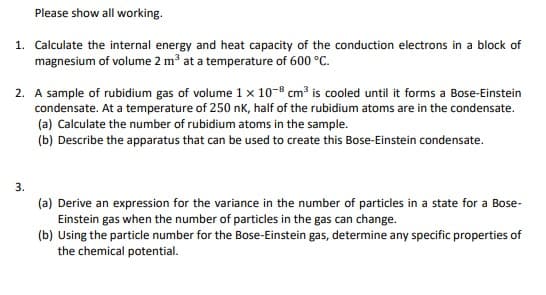3. (a) Derive an expression for the variance in the number of particles in a state for a Bose- Einstein gas when the number of particles in the gas can change. (b) Using the particle number for the Bose-Einstein gas, determine any specific properties of the chemical potential.
3. (a) Derive an expression for the variance in the number of particles in a state for a Bose- Einstein gas when the number of particles in the gas can change. (b) Using the particle number for the Bose-Einstein gas, determine any specific properties of the chemical potential.
Related questions
Question
Q3 a and b

Transcribed Image Text:Please show all working.
1. Calculate the internal energy and heat capacity of the conduction electrons in a block of
magnesium of volume 2 m³ at a temperature of 600 °C.
2. A sample of rubidium gas of volume 1 x 10-8 cm3 is cooled until it forms a Bose-Einstein
condensate. At a temperature of 250 nK, half of the rubidium atoms are in the condensate.
(a) Calculate the number of rubidium atoms in the sample.
(b) Describe the apparatus that can be used to create this Bose-Einstein condensate.
3.
(a) Derive an expression for the variance in the number of particles in a state for a Bose-
Einstein gas when the number of particles in the gas can change.
(b) Using the particle number for the Bose-Einstein gas, determine any specific properties of
the chemical potential.
Expert Solution
This question has been solved!
Explore an expertly crafted, step-by-step solution for a thorough understanding of key concepts.
This is a popular solution!
Trending now
This is a popular solution!
Step by step
Solved in 4 steps with 3 images
